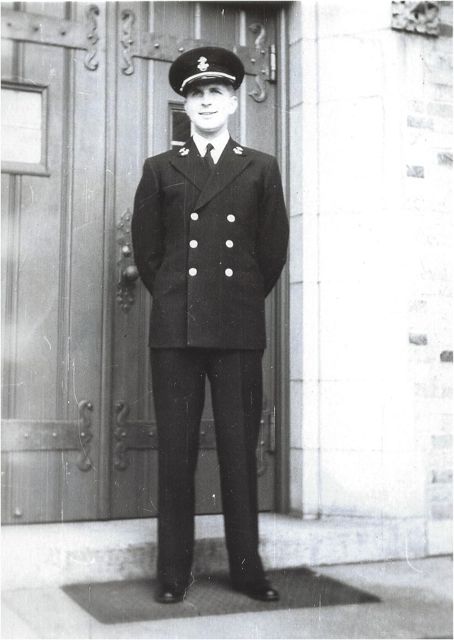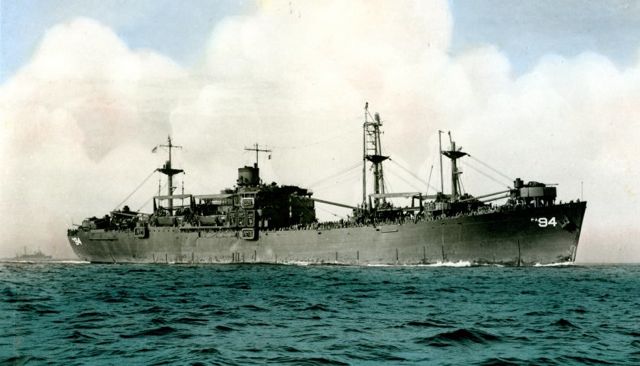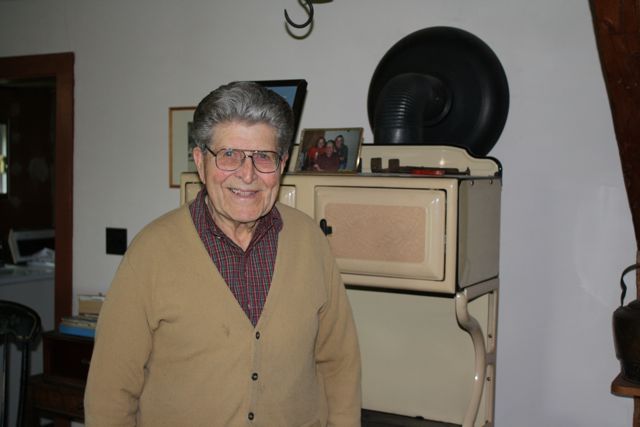Bill Ston: A man with a commanding presence at war and at peace
By John T. Ryan
June 9 – Generations of Peru Central School students remember Bill Ston as their high school chemistry teacher. Yesterday another important part of Bill’s life was recalled as he joined fifteen other World War II veterans on the North Country Honor Flight to Washington DC. The veterans toured the World War II Memorial, the Iwo Jima Monument and Arlington Cemetery.
Commissioned as an Ensign in the U.S. Navy on January 20, 1944, following his graduation from St. Lawrence University and the V-12 Officer Training Program at Notre Dame University, Bill Ston was on active duty from January 1944 to January 1946. Assigned to the attack transport the USS Baxter, he commanded boats as they landed men and equipment on the Philippine Islands of Leyte and Luzon and the Japanese islands of Okinawa. The Leyte invasion took place in October and November 1944; Luzon in January 1945; and Okinawa in April 1945.
Ston described his duties, “I was in charge of a number of boats. It was my responsibility to see everyone got to the beach. My boat was in the middle of what we called an assault wave.” He witnessed Japanese kamikaze attacks at both Leyte and Okinawa. He said, “At Leyte a kamikaze aircraft attacked a distant ship and a nearby ship. Instead of coming after us, it turned and smashed into the side of the other ship. It looked like he was going to come right towards us. It scared the hell out of me.”
While the USS Baxter didn’t encounter active opposition at Okinawa, landing troops and equipment in unknown waters was difficult. Ston explained, “The landing boats always leaked water. Something plugged the pumps on my boat and we were low in the water. I sent signals to the other boats to continue.”
Fortunately, a repair crew rapidly came to Ston’s assistance and he was able to off-load about 30 U.S. Army troops and equipment. Unfortunately, when the small Army vehicle descended the ramp into what appeared to be shallow water, it disappeared into the Pacific waters. Ston believes that it drove off the edge of a coral reef.
Bill Ston taught high school science in Peru from 1949 to 1977. He is 92 years of age and resides on the Barney Downs Road in Peru. Anyone who attends a local community dinner is likely to see Bill in attendance accompanied by either his daughter Julie Liberty and her husband Gary or his son Joe Ston and his wife Susan.
Posted: June 9th, 2013 under General News.
Comments
Comment from Wila
Time June 10, 2013 at 11:37 pm
Agree, in that is a GREAT story & that I’m so.. sorry that he & my Dad (didn’t have a chance to share their experiences)!! Some of U may may remember that Dad was in WWII, recalled 4 the Korean War & stayed in the Air Force, ended up flying C19 & B47s & B52s in Plattsburgh & then Vietnam, dropping troops/supplies, and finally retiring from the Air Force, then to retire from the FAAC!! Remember, we came 2 Peru from Germany, because base housing wasn’t finished! Unreal memories & it’s such a small world!!
Comment from Edmund S. Copeland, Ph.D.
Time June 11, 2013 at 8:09 pm
Mr. Ston took me through General Science grade 9, Physics grade 10, Chemistry grade 11 and Biology grade 12. He and Mr. Donald Ledwith and James Hutchinson who with Anne Cordic launched me to Cornell, firstt as an Engineering Physicist, then as a psych major pre med and a zoology major premed and finally as a chemistry major with a great deal of zoology. applied to four med schools in 1957 and was accepted at Yale, Cornell, McGill and Rochester. Study was interrupted many times by bipolar disorder but when I was off highs and lows, I led the grad school class in radiological physics, statistics ad assisted George Berg, Ph.D. in teaching biology to engineers and physical scientists.
5thus,
bill Ston got me started.
ed copeland



Comment from Dan Case
Time June 9, 2013 at 2:56 pm
Very nice story and glad that Mr. Ston got to see the memorial. Wish my Dad could have before he passed…he served at about the same time Mr. Ston did, but in Army Air Corps in Italy. His unit was on its way to the Pacific when the war ended.